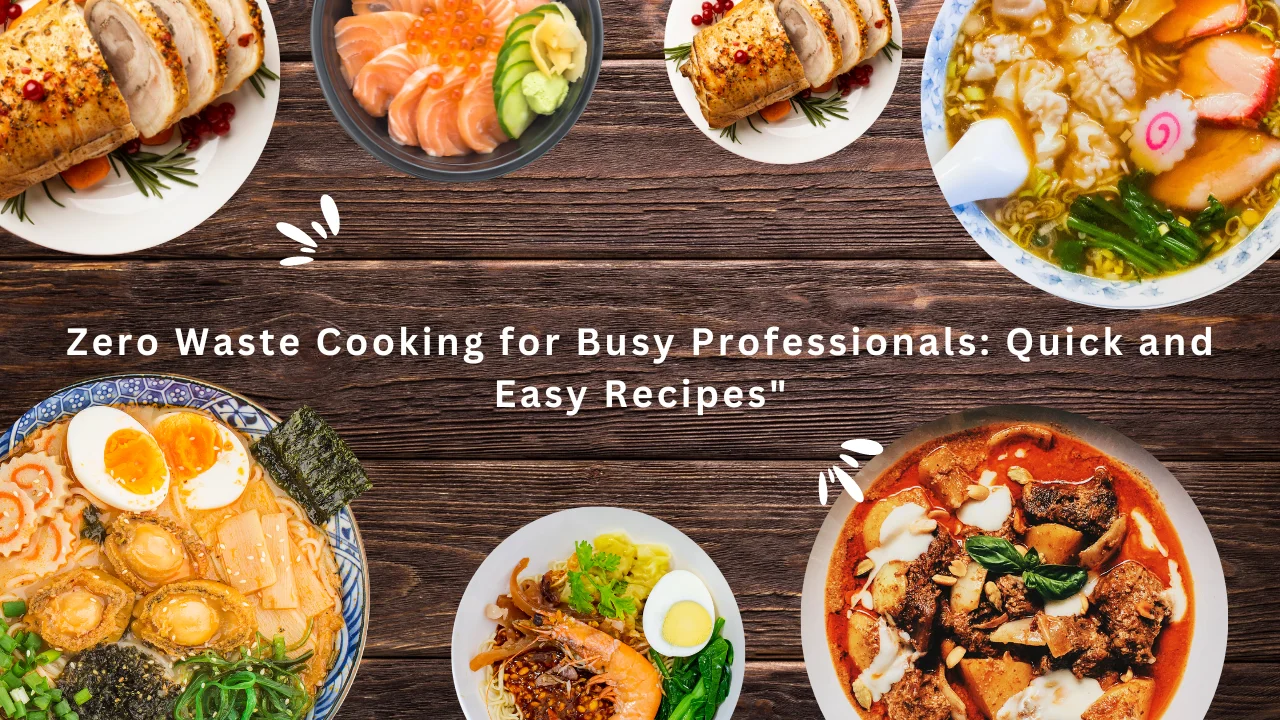In today’s fast-paced world, finding time to cook can be challenging, especially for busy professionals. At the same time, the desire to reduce waste and make environmentally friendly choices remains strong. Zero waste cooking offers a way to enjoy healthy, homemade meals without generating excessive waste, even with a packed schedule. Here’s how you can integrate zero waste practices into your cooking routine with quick and easy recipes designed for busy lifestyles.
Why Zero Waste Cooking Matters
Zero waste cooking not only helps reduce your environmental footprint but also often leads to healthier meals and savings. By focusing on using every part of your ingredients and minimizing packaging waste, you can make a positive impact on both your life and the planet. For busy professionals, the key is to streamline the process without sacrificing convenience or quality.
Quick and Easy Zero Waste Recipes
1. Veggie Stir-Fry
Ingredients:
- Mixed vegetables (e.g., bell peppers, carrots, broccoli, and snap peas)
- Cooked rice or quinoa
- Soy sauce or tamari
- Garlic and ginger (optional)
- Leftover protein (e.g., chicken, tofu, or beans)
Instructions:
- Prep Veggies: Slice any vegetables you have on hand. This is a great way to use up odds and ends from your fridge.
- Stir-Fry: Heat a pan with a bit of oil and sauté garlic and ginger if using. Add vegetables and cook until tender-crisp.
- Add Protein: Stir in your leftover protein if you have any.
- Season: Add soy sauce or tamari to taste.
- Serve: Serve over cooked rice or quinoa.
Waste Reduction Tip: Use up any leftover vegetables or protein you have in your fridge. Freeze leftover rice or quinoa in individual portions for quick future meals.
2. One-Pan Roasted Vegetables
Ingredients:
- A mix of root vegetables (e.g., potatoes, sweet potatoes, carrots, beets)
- Olive oil
- Herbs and spices (e.g., rosemary, thyme, paprika)
- Salt and pepper
Instructions:
- Prep Vegetables: Peel and cut vegetables into uniform pieces.
- Season: Toss with olive oil, herbs, spices, salt, and pepper.
- Roast: Spread on a baking sheet and roast at 400°F (200°C) for 25-30 minutes, or until tender and golden.
- Serve: Enjoy as a side dish or as a base for grain bowls.
Waste Reduction Tip: Save vegetable peels and scraps to make homemade vegetable broth. Just freeze them until you have enough.
3. Quick Chickpea Salad
Ingredients:
- 1 can of chickpeas (or cooked chickpeas)
- Cherry tomatoes, halved
- Cucumber, diced
- Red onion, finely chopped
- Lemon juice
- Olive oil
- Salt and pepper
Instructions:
- Mix Ingredients: In a bowl, combine chickpeas, cherry tomatoes, cucumber, and red onion.
- Dress: Drizzle with olive oil and lemon juice. Season with salt and pepper.
- Toss: Mix everything together and serve.
Waste Reduction Tip: Use leftover vegetables from your fridge. You can also freeze leftover chickpeas for future use.
4. Egg and Veggie Muffins
Ingredients:
- Eggs (about 6)
- Mixed vegetables (e.g., spinach, bell peppers, onions)
- Cheese (optional)
- Salt and pepper
Instructions:
- Preheat Oven: Preheat to 375°F (190°C).
- Prep Veggies: Chop vegetables and sauté if desired.
- Mix Eggs: Beat eggs in a bowl and season with salt and pepper.
- Assemble Muffins: Place vegetables (and cheese if using) into muffin tin cups. Pour eggs over the top.
- Bake: Bake for 20-25 minutes, or until eggs are set.
Waste Reduction Tip: Use up leftover vegetables and cheese. Muffins can be frozen for quick breakfasts or snacks.
5. Simple Pasta with Tomato Sauce
Ingredients:
- Pasta of choice
- Canned tomatoes or tomato sauce
- Garlic and onion, finely chopped
- Olive oil
- Dried herbs (e.g., basil, oregano)
- Parmesan cheese (optional)
Instructions:
- Cook Pasta: Follow package instructions to cook pasta.
- Make Sauce: In a pan, sauté garlic and onion in olive oil. Add canned tomatoes or tomato sauce and herbs. Simmer for 10-15 minutes.
- Combine: Toss cooked pasta with the sauce.
- Serve: Top with Parmesan cheese if desired.
Waste Reduction Tip: Save pasta cooking water to thicken the sauce if needed. Use leftover sauce for future meals or freeze in portions.
Tips for Busy Professionals
- Meal Prep: Dedicate a few hours each week to prepare ingredients or cook in bulk. Store meals in reusable containers for quick access.
- Keep It Simple: Focus on recipes that require minimal prep and cooking time.
- Plan Ahead: Use meal planning apps or simple lists to organize your meals and make efficient grocery lists, reducing impulse buys and waste.
Conclusion
Zero waste cooking doesn’t have to be time-consuming or complicated, even for busy professionals. By incorporating these quick and easy recipes into your routine and adopting a few waste-reducing practices, you can enjoy delicious, homemade meals while contributing positively to the environment. Embrace the challenge of zero waste cooking, and you’ll find that efficiency and sustainability can go hand in hand.
